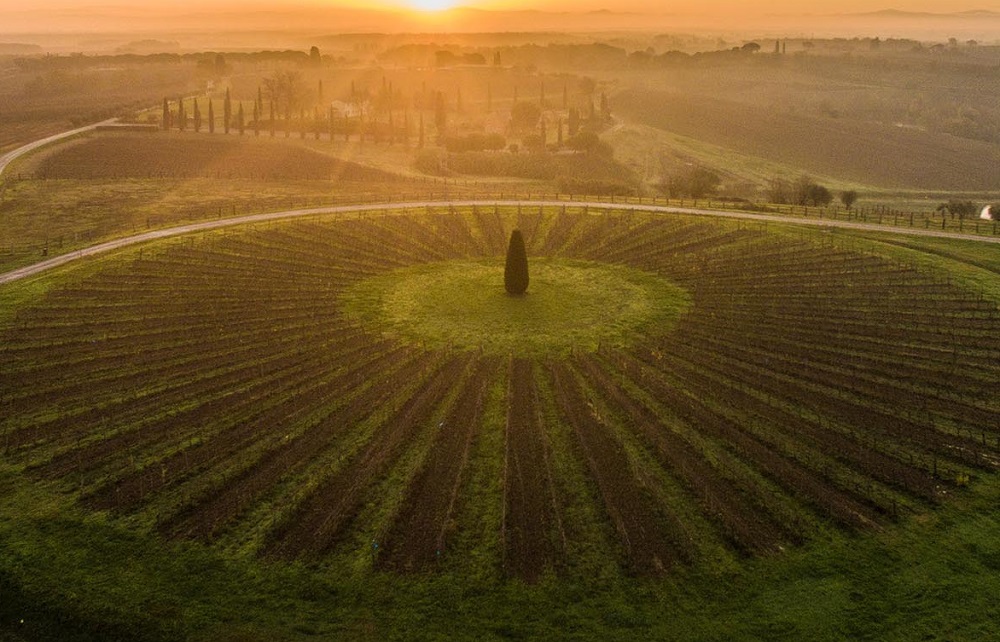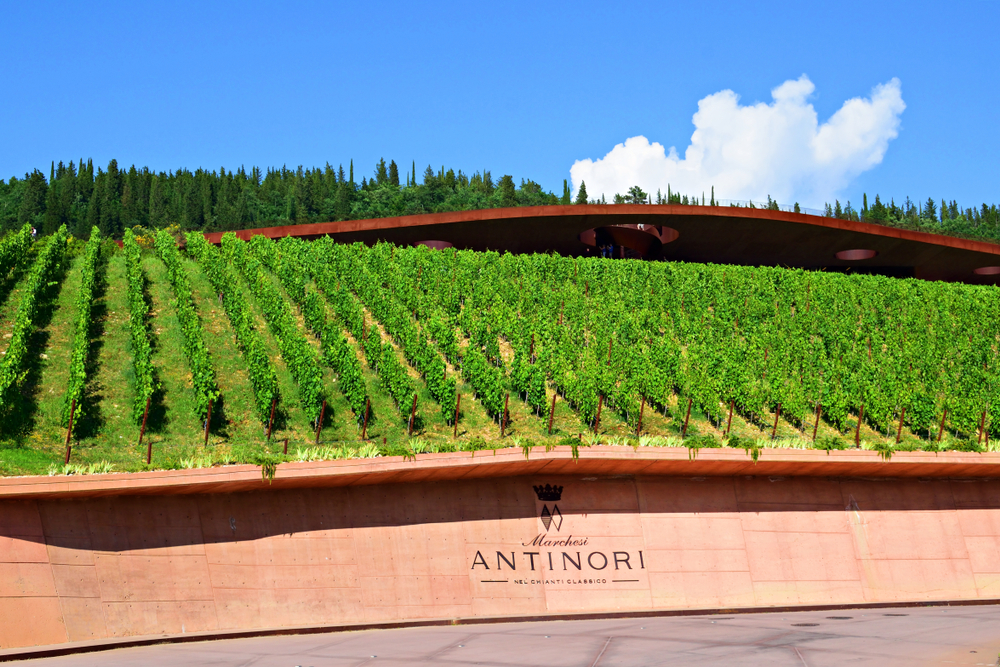
Exploring Italy’s Design Wineries: A Fusion of Iconic Architecture and Exquisite Wines
August 8, 2017
Explore seven unique Italian wineries, where world-class architecture meets winemaking, from Antinori's Tuscan cellars to the iconic Ceretto 'Cube'
By: Genevieve Mc Carthy / Last updated: February 9, 2024
Estimated reading time: 10 minutes
Sightseeing and wine drinking in Tuscan Wine Country – is there a more perfect combination in life? Even Bacchus, the god of wine, would envy a road trip through Tuscany’s wine heartlands, marveling at the most spectacular scenery on earth. To taste, drink, and dine exceedingly well, this magical land has no peers. For who could resist the rolling hills, the cypresses, the vine-clad slopes, the dreamy sunsets?

The Etruscans understood this too well – they cultivated Chianti’s signature variety, Sangiovese, in the 8th century BC. Many centuries later, Tuscany brims with traditional wine styles such as Chianti and Brunello and a growing number of so-called Super Tuscans – the collectors’ favorite. There is a lifetime’s worth of excitement here to tempt even the most jaded oenophile, but one lifetime in Tuscany is scarcely enough.
So the only problem, if you’ll forgive the cliché, is knowing where to start and who to prioritize if you’re relatively short on time. At least in our summation, the following are the cream of the crop, the best of the best—the elite of Tuscan winemaking and hospitality.

It needs little introduction – Badia Passignano is the jewel in the vast Antinori family portfolio. The estate was purchased by the Antinori in 1987 – their dream was to produce a flagship Chianti Riserva wine based on exceptional terroir, old Chianti vines, and state-of-the-art winemaking. Today, visits to Chianti don’t get much more atmospheric – the hamlet was built around a Benedictine Vallombrosan abbey, which showcases a magnificent fresco of The Last Supper. Head here to admire the spectacular views before savoring the Michelin-starred gastronomy of Osteria di Passignano. It has long been one of Tuscany’s best-loved dining destinations. Intricate, Tuscan-inspired dishes fly the local-produce flag, and the wine list is imposing. It doesn’t get much better than this.
Website: www.antinori.it

Without wishing to indulge in hyperbole, this ancient estate is an oenophiles’ dream come true. A handsome abbey-cum-hotel and winery sits in a silent landscape high in the Chianti hills – a place where time has been suspended. Offering soaring views across the Arno Valley, superlative wines, gastronomy, and hospitality, it’s not difficult to see why aficionados return every year. It is run by the sixth generation of the Stucchi Prinetti family, who purchased the estate and vineyards in 1846. Practicing organic viticulture and sustainable practices, their range of Chianti Classicos are among the best in the region. The whole package is simply superb – a destination to enjoy the finer things in life and shut out the modern world. Relaxation isn’t a possibility at Badia a Coltibuono; it’s a certainty.
Website: www.coltibuono.com

Owned by the legendary Frescobaldi family, Castello di Nipozzano sits in the heart of Chianti Rufina – an undulating, majestic landscape of vineyards, cypresses, and olive groves. It is the oldest estate owned by the family, a winemaking dynasty with a history dating back to the early 1300s. They became famous in the 15th century for supplying wines to Renaissance artists such as Donatello. Today, their portfolio is vast and impressive – nowhere is this more evident than at Castello di Nipozzano. Situated on the mountainous side of the region, overlooking the Arno, di Nipozzano produces a range of delicious Super Tuscan and Chianti Rufina wines. There are over 626 hectares, and the striking castle, which clings to a prominent hilltop, dates back over 900 years. The perfect introduction to the wines of Chianti Rufina, the Frescobaldi always do things in style.
Website: frescobaldi.com

Devotees of striking contemporary art and fine wines will love Castello di Ama. You’re in the heart of Chianti Classico, an idyllic landscape of rolling hills and cypress-clad winding lanes. This estate was referenced as far back as the 10th century – in the 11th century AD, Ama was the beneficiary of several privileges granted by the Holy Roman Emperors Henry VI and Otto IV. Its modern history began about 40 years ago, with the replanting of the estate vineyards.
Today, it is run by the genial couple Lorenza and Marco, who have invested enormous time and energy into elevating Castello di Ama’s wines to some of the region’s best. Yet this gorgeous estate produces some of Chianti’s most impressive wine and has become a contemporary art showcase. The accommodation is no less luxurious; offering four renovated suites in one of the estate’s 18th-century villas, it’s the perfect spot to appreciate the finer things in life.
Website: www.castellodiama.com

Welcome to the heart of the stunning Val d’Orcia. Few valleys are as magnificent as this, and few luxury wine estates set the standard so high as Castiglion del Bosco. Owned by fashion guru Massimo Ferragamo, the estate has over 141 acres planted to Sangiovese used to produce excellent examples of the legendary Brunello di Montalcino. Ferragamo purchased the winery in 2003 and has since raised the bar in winemaking dramatically. Nowhere is this more evident than in the single-vineyard Campo del Drago. After a fantastic tasting, why not retire to the adjoining luxury spa and golf resort, renowned as one of the most abundant in Italy. An 18-hole golf course designed by Tom Weiskopf is merely the icing on the cake – this wine estate and hotel is the epitome of glamor, a must-visit destination for any discerning sybarite.
Website: www.castigliondelbosco.com

This fabulous wine estate and boutique hotel are among the best of Brunello di Montalcino’s new firmament. Founded in 1971 by Giacomo Neri, Casanova has risen quickly from relative obscurity to the status of one of Italy’s finest wineries. Showered with awards from Wine Spectator and the eminent critic James Suckling, Casanova di Neri produces utterly divine, magnificent Brunellos. With his son Giovanni, Giacomo crafts distinctive, terroir-driven Brunellos that triumph even in weaker vintages – particularly the multi-vineyard blend Tenuta Nuova single-vineyard Cerretalto. Attached to the estate is a lovely relais property, offering luxury and relaxed hospitality—a destination to savor the best of Tuscany’s La Dolce Vita.
Website: www.casanovadineri.it

This is an extraordinary part of Tuscany. Nestled in the majestic landscape of Montepulciano, Avignonesi is named after the founders of the estate – a historic landmark in local viticulture. Purchased by Belgium Virginie Saverys in 2009, Avignonesi has grown in size and, at the same time, has become a leader in biodynamic/sustainable grape-growing and winemaking. Cultivating over 170 hectares of vineyards, the team at Avignonesi makes a range of excellent red and white wines, including some sought-after Super Tuscans. The warm welcome and hospitality here are also unrivaled – the best in the region.
Website: www.avignonesi.it

A name synonymous with wine across Tuscany, the origins of Tuscany’s wine renaissance emerged from the cellars of the Antinori family, one of the region’s most historic wine growers. Indeed, the name Antinori has been associated with wine since the 14th century, when Giovanni di Piero Antinori joined the Florentine Guild of Vintners in 1385. Many centuries later, the family added the Tignanello vineyard to its portfolio in 1900. Niccolò Antinori and his son Piero began experimenting with then-unheard-of winemaking techniques and grape varieties. The first vintage of Tignanello was released in 1971 to critical acclaim.
Today, the firm’s flagship winery in Chianti Classico is a must-visit. In 2012, they opened a fantastic new winery, visitor center, and restaurant. Designed by Marco Casaminta, the sculptural building set into the hillside is a landmark sight in Tuscany. The onsite facilities, including a boutique and shop, are undoubtedly the best in Chianti – Rinuccio 1180, the winery’s signature restaurant, is extraordinary indeed. Built on the rooftop of the sleek winery, this top-flight destination seats diners in the summer months on a spectacular terrace with fantastic views of the surrounding vineyards.
Website: www.antinori.it

Owner Michele Manelli knew he was onto a good thing when he purchased this magical estate at the heart of Montepulciano. The Sangiovese-based wines are excellent, but even more remarkable is Manelli’s commitment to sustainability and biodiversity – a leader in the region and an example for all others to follow. Salcheto, named after the stream which springs at the foot of the town of Montepulciano, was the first company in the world to certify the carbon footprint of a wine bottle. They generate all their own power needs and strive to manage their vineyards without using harmful, man-made chemical inputs. A beacon of eco-friendly winemaking, Salcheto also boasts some of the most charming accommodations in Montepulciano.
Website: www.salcheto.it

Few families have done more for the reputation of Chianti Classico than the Bianchi family. Founded in the middle of the 18th century, the castle was a wedding gift from the patriarch Aldo to Fabrizio Bianchi and his wife, Giuliana. After an extensive replanting program and an unprecedented investment into winemaking, Castello di Monsanto is now regarded as one of the most reliable sources of excellent Chianti Classico. Since 1996, the management of di Monsanto has passed to the third generation of the family: Fabrizio’s daughter Laura. She understands that complacency is the death of fine wine – this remarkable estate strives to raise the bar even higher in quality winemaking and hospitality. Beautiful, tranquil, historic, and architecturally splendid, there is a lifetime’s worth of excitement in Chianti for the adventurous oenophile.
Website: www.castellodimonsanto.it
If you would like us to customize an exclusive luxury tour, contact us and let us know your travel plans. We offer luxury food and wine tours for private groups of a minimum two guests. In addition, all of our private, chauffeured tours are available year-round upon request.

